Mastering Anatomy for Radiologic Technologists is not just a prerequisite but a foundation for those eager to excel in the field. The intricacies of the human body and its structures can be daunting, but with the right resources and strategies, it becomes an intriguing journey of discovery.
This guide offers a comprehensive roadmap to understanding anatomy, ensuring you’re well-equipped and confident as you step into the world of radiology.
How to Mastering Anatomy for Radiologic Technologists
1. Anatomy Posters:
Whether you’re gearing up for an Anatomy & Physiology (A&P) class or diving deep into the Radiologic Technologist (RT) program, a good visual aid can be invaluable. Posters featuring labeled anatomical structures can be found on platforms like Amazon and can be a great asset to any study space.
2. Interactive Learning with PurposeGames:
Ditch the traditional ways and dive into interactive learning. PurposeGames offers a plethora of labeling exercises for various anatomical structures. From skull bones to intricate muscle systems, it’s a treasure trove for those looking to challenge their knowledge.

3. The Classic Anatomy Coloring Book:
There’s something therapeutic about coloring, and when it combines with learning, it’s a win-win. The Anatomy Coloring Book is a brilliant resource that many recommend. It’s not only a fun way to learn but also helps retain information.
4. Real Bones:
Some of our fellow technologists swear by the use of real anatomical specimens like skulls. Not only do they give a hands-on feel but they also allow you to see and understand the intricacies.
5. Radiography Roadmap:
One of the hidden gems that many might miss out on is the Radiography Roadmap available on the ASRT website. This is a free, interactive module with an anatomy review specifically tailored for radiologic technologists.
6. Using Body Landmarks:
Understanding how to use body landmarks can be a game-changer, especially in trauma radiography. For instance, knowing the elbow aligns with L3-L4 can be crucial to never missing an L-spine again.
7. Practice Makes Perfect:
Sometimes, all you need is a willing partner. Practicing exam positions and understanding anatomical structures using a real person can be quite helpful. Some have even made use of their spouses to perfect their craft!
8. Anatomy Apps and Tools:
The digital age has blessed us with numerous anatomy apps, both free and paid. They serve as a great tool for understanding and visualizing anatomical structures on the go.
9. Anatomical Skull:
While a full skeleton might be overdoing it a bit, an anatomical skull can be a worthy investment. Many programs even require one.
Conclusion:
Mastering anatomy for radiologic technologists is both an art and a science. As the medical field continues to evolve, staying updated with the most accurate anatomical knowledge becomes crucial. This comprehensive guide has aimed to shed light on the essentials, tools, and best practices to help every technologist achieve this mastery.
As you venture further into the world of radiology, may your understanding of anatomy serve as a robust foundation for all the incredible work you’ll undertake.

